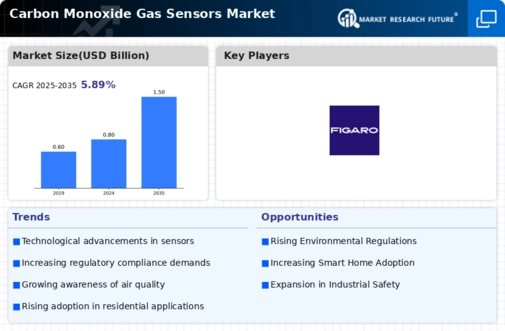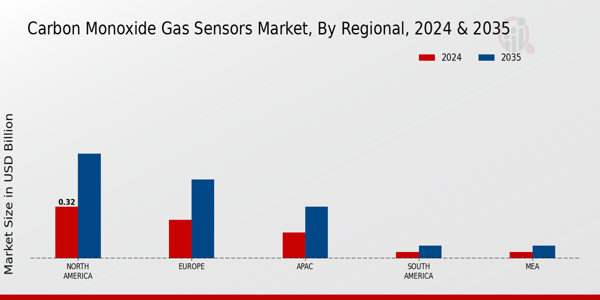Technological Innovations
Technological innovations are playing a pivotal role in shaping the Carbon Monoxide Gas Sensors Market. The development of advanced sensor technologies, such as electrochemical and semiconductor sensors, is enhancing the accuracy and reliability of carbon monoxide detection. These innovations are not only improving performance but also reducing costs, making sensors more accessible to a broader audience. Furthermore, the integration of smart technologies, such as IoT connectivity, is enabling real-time monitoring and alerts, which is particularly appealing to consumers and businesses alike. As these technologies continue to evolve, they are expected to drive significant growth in the Carbon Monoxide Gas Sensors Market, as stakeholders seek to leverage the benefits of enhanced detection capabilities.
Rising Awareness of Health Risks
The Carbon Monoxide Gas Sensors Market is significantly influenced by the rising awareness of health risks associated with carbon monoxide exposure. As public knowledge about the dangers of carbon monoxide poisoning increases, there is a growing demand for effective detection solutions in residential and commercial settings. This heightened awareness is prompting consumers to invest in carbon monoxide detectors, thereby driving market growth. Reports suggest that the residential segment is expected to witness considerable expansion, as homeowners seek to protect their families from potential hazards. The emphasis on health and safety is likely to propel the Carbon Monoxide Gas Sensors Market forward, as more individuals recognize the importance of proactive measures against carbon monoxide exposure.
Growth in Smart Home Technologies
The Carbon Monoxide Gas Sensors Market is witnessing growth driven by the increasing adoption of smart home technologies. As consumers become more inclined towards home automation, the integration of carbon monoxide sensors into smart home systems is becoming more prevalent. These sensors not only provide essential safety features but also enhance the overall functionality of smart homes by offering remote monitoring and alerts through mobile applications. The convenience and peace of mind associated with smart home solutions are likely to attract more consumers, thereby expanding the market. Projections indicate that the smart home segment will contribute significantly to the Carbon Monoxide Gas Sensors Market, as technological advancements continue to shape consumer preferences and behaviors.
Increasing Industrial Applications
The Carbon Monoxide Gas Sensors Market is experiencing a surge in demand due to the increasing applications in various industrial sectors. Industries such as manufacturing, oil and gas, and chemical processing are increasingly adopting these sensors to ensure safety and compliance with regulations. The need for real-time monitoring of carbon monoxide levels in these environments is critical, as exposure can lead to severe health risks. According to recent data, the industrial segment is projected to account for a substantial share of the market, driven by the necessity for enhanced safety measures and the implementation of stringent safety protocols. This trend indicates a robust growth trajectory for the Carbon Monoxide Gas Sensors Market, as industries prioritize worker safety and operational efficiency.
Regulatory Standards and Compliance
The Carbon Monoxide Gas Sensors Market is significantly impacted by the establishment of regulatory standards and compliance requirements across various sectors. Governments and regulatory bodies are increasingly mandating the installation of carbon monoxide detectors in residential and commercial buildings to safeguard public health. These regulations are driving the adoption of carbon monoxide sensors, as non-compliance can result in severe penalties. The market is likely to benefit from these regulatory frameworks, as they create a conducive environment for growth. Additionally, industries such as automotive and construction are also facing stricter regulations regarding emissions and safety, further propelling the demand for carbon monoxide detection solutions. This trend indicates a promising outlook for the Carbon Monoxide Gas Sensors Market as compliance becomes a priority.

















Leave a Comment